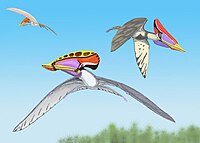Formacja Santana
Formacja Santana (port. Formação Santana) – formacja geologiczna składająca się ze skał osadowych, występująca w północno-wschodniej Brazylii (stany Pernambuco), Piauí i Ceará), w basenie Araripe (port. Bacia do Araripe). Jej wiek oceniany jest na późną kredę. Znana z występowania licznych skamieniałości[1].
Nazwa
[edytuj | edytuj kod]Nazwa formacji pochodzi od miejscowości Santana do Cariri, gdzie skały te odkryto i opisano po raz pierwszy.
Wiek
[edytuj | edytuj kod]Wiek formacji został oznaczony na górną kredę (dolny cenoman – ok. 92 mln lat temu).
Opis
[edytuj | edytuj kod]Formacja Santana składa się głównie ze skał osadowych.
Położenie
[edytuj | edytuj kod]Formacja Santana należy do grupy Araripina (port. Grupo Araripina).
Poniżej zalega formacja Crato (port. Formação Crato).
Skamieniałości
[edytuj | edytuj kod]W skałach formacji Santana oznaczono liczne, dobrze zachowane skamieniałości (Fossillagerstätte), często pozwalające określić warunki środowiska. W 1996 r. został opisany nowy gatunek maniraptora[1].
Oznaczone gatunki
[edytuj | edytuj kod]Dinozaury
[edytuj | edytuj kod]Wiele gatunków wymarłych zwierząt zostało opisanych w Estado do Ceara[2].
| Dinozaury i ptaki formacji Santana | ||||
|---|---|---|---|---|
| Rodzaj | Gatunek | Występowanie | Uwagi | Wizualizacja |
|
A. limai[2] |
Estado do Ceara, Brazylia[2]. |
Spinosauridae. Rostralna część czaszki[3]. Synonim Irritator challengeri. |
||
|
I. challengeri[2] |
Estado do Ceara, Brazylia[2]. |
Spinosauridae. Fragmenty czaszki[3]. | ||
|
M. asymmetrica[2] |
Estado do Ceara, Brazylia[2]. |
|||
|
S. placidus[2] |
Estado do Ceara, Brazylia[2]. |
Fragmenty szkieletu pozaczaszkowego[4]. | ||
| Pterodaktyle formacji Santana | ||||
|---|---|---|---|---|
| Rodzaj | Gatunek | Występowanie | Opis | Wizualizacja |
|
Araripedactylus dehmi |
  | |||
|
Araripesaurus castilhoi |
||||
|
Barbosania[5] |
Barbosania gracilirostris |
|||
|
Cearadactylus atrox |
||||
|
Pricesaurus |
"Pricesaurus megalodon" |
|||
|
Santanadactylus |
Placeholder placeholder |
|||
|
Tapejara wellnhoferi |
||||
|
Tropeognathus mesembrinus |
||||
|
Romualdo Member |
|||
Żółwie
[edytuj | edytuj kod]| Żółwie formacji Santana | ||||
|---|---|---|---|---|
| Rodzaj | Gatunek | Występowanie | Opis | Wizualizacja |
|
Santanachelys |
Protostegidae, Cryptodira |
 | ||
Gospodarka
[edytuj | edytuj kod]Skały formacji Santana były eksploatowane jako surowce ceramiczne. Obecnie trwa nielegalny handel skamieniałościami pozyskiwanymi z tej formacji.
Przyroda
[edytuj | edytuj kod]W trakcie wietrzenia skał formacji Santana powstaje gleba o nietypowym składzie, poza tym niespotykana nigdzie w tym regionie.
W górach pada do Araripe występuje endemiczny gatunek ptaka skoczek królewski (Antilophia bokermanni).
Zobacz
[edytuj | edytuj kod]- Santana Formation fossils
- American Museum of Natural History:. amnh.org. [zarchiwizowane z tego adresu (2005-04-04)]. Brazilian fossil fishes
Przypisy
[edytuj | edytuj kod]- ↑ a b Maisey, J.G., Rutzky, I., Blum, S. & W. Elvers (1991): Laboratory Preparation Techniques. In Maisey, j:G. (ed): Santana Fossils: An Illustrated Atlas, Tfh Pubns Inc. ISBN 0-86622-549-8. pp 99–103
- ↑ a b c d e f g h i j k l m Weishampel, David B; et al. (2004). "Dinosaur distribution (Early Cretaceous, South America)." In: Weishampel, David B.; Dodson, Peter; and Osmólska, Halszka (eds.): The Dinosauria, 2nd, Berkeley: University of California Press. Pp. 563-570. ISBN 0-520-24209-2.
- ↑ a b "Table 4.1," in Weishampel, et al. (2004). Page 73.
- ↑ "Table 5.1," in Weishampel, et al. (2004). Page 114.
- ↑ Ross A. Elgin and Eberhard Frey (2011) A new ornithocheirid, Barbosania gracilirostris gen. et sp. nov. (Pterosauria, Pterodactyloidea) from the Santana Formation (Cretaceous) of NE Brazil Swiss Journal of Palaeontology (advance online publication) DOI: 10.1007/s13358-011-0017-4 [1]
Bibliografia
[edytuj | edytuj kod]- Grimaldi David A. (red.) 1990. Insects from the Santana Formation, Lower Cretaceous, of Brazil, Bulletin of the American Museum of Natural History no. 195
- Maisey John G. (red.) 1991. Santana Fossils – An Illustrated Atlas (T.H.F. Publ.)
- Maisey, John G., Rutzky, I., Blum, S. & W. Elvers (1991): Laboratory Preparation Techniques. In Maisey, j:G. (red): Santana Fossils: An Illustrated Atlas, Tfh Pubns Inc.ISBN 0-86622-549-8. pp 99–103
- Martill David M., 1993. Fossils of the Santana and Crato Formations, Brazil (Field Guide to Fossils no. 5) (The Palaeontological Association) ISBN 0-901702-46-3
Text is available under the CC BY-SA 4.0 license; additional terms may apply.
Images, videos and audio are available under their respective licenses.
